A chihuahua-pug cross was left with weeping blisters on its face after it brushed past a giant hogweed plant.
Sue Earley was walking ‘Peanut’ in Fordingbridge, Hampshire, when the dog was scorched by ‘Britain’s most dangerous plant’.
The dog initially developed a lump on its nose which quickly turned into angry red blisters.
Giant hogweed contains a sap that stops the skin protecting itself against the sun’s rays, causing severe burns when exposed to natural light.
Mrs Earley said: ‘It became obvious a while after we got home – probably about 30 minutes later. She came in from the garden with a lump on her nose.
‘I thought at first she’d been stung by a bee or wasp. There were no signs apart from the lump – it was perfectly normal.

Sue Earley was walking ‘Peanut’ (pictured) in Fordingbridge, Hampshire, when the dog was scorched by ‘Britain’s most dangerous plant’. Pictured: The burn four days after exposure

Pictured: Sue Earley with her dog, Peanut who was burnt on the nose by giant hogweed

Giant hogweed contains a sap that stops the skin protecting itself against the sun’s rays, causing severe burns when exposed to natural light
‘I gave the lump a wash, which I think probably helped as it washed the sap off.
‘But the lump gradually got bigger over the course of the day, and by the next morning she had weeping blisters that looked red and sore.’
Giant hogweed burns often don’t cause immediate pain, meaning people or animals continue to burn in the sun without noticing a problem.
The plant scorches people every year – including children, but dogs are at risk too.
And the plant can spread its sap with only a moment’s exposure.
Mrs Earley continued: ‘She could have only been exposed for a second or two, but that’s all it takes.
‘It is growing very tall where people walk their dogs. It had been trodden on, which releases the sap.’

The dog initially developed a lump on its nose which quickly turned into angry red blisters. Pictured: The burn one day after exposure

Giant hogweed burns often don’t cause immediate pain, meaning people or animals continue to burn in the sun without noticing a problem. Pictured: The burn five days after exposure

Pictured: Peanut’s nose three days after the exposure to the giant hogweed

The plant scorches people every year – including children, but dogs are at risk too
Peanut, who was adopted from Hungary Hearts Dog Rescue, was taken to an emergency vet on Sunday – the day after exposure.
Read More
Britain faces record invasion of 'dangerous' Giant Hogweed after mild and wet weather sees toxic plant that causes painful burns bloom earlier than ever

She was given a steroid injection and antibiotic tablets, and is now on the road to recovery.
However, Mrs Earley now wants to warn others about the dangerous plant.
She said: ‘Most people don’t know about giant hogweed – it looks like a big cow parsley, which is harmless.
‘If you’re not sure, stay away and check your dogs over regularly – if it hadn’t been on her nose, I wouldn’t have seen it for ages.
‘I sincerely hope this information will stop any other human or dog coming into contact with giant hogweed.’
The giant hogweed is native to the Caucasus, but was introduced to Britain as an ornamental plant in 1817, and its spread has now got out of control.
It was called ‘without a shadow of a doubt, the most dangerous plant in Britain’ by Mike Duddy, of the Mersey Basin Rivers Trust in 2015.
